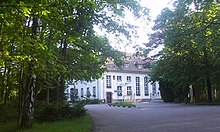Dump chairs
|
Dump chairs
municipality Hövelhof
Coordinates: 51 ° 49 ′ 8 ″ N , 8 ° 43 ′ 8 ″ E
|
|
|---|---|
| Height : | 127 m above sea level NN |
| Residents : | 266 (Nov. 30, 2005) |
| Postal code : | 33161 |
| Area code : | 05257 |
Staumühle is a place on the southeast border of the municipality Hövelhof to Bad Lippspringe in the Paderborn district and is located in the middle of the Senne on the upper reaches of the Haustenbach , bordering the Senne military training area in the south and east . Sennelager is about 5 km south, the Hövelhofer district Klausheide about 3 km southwest and the Hövelhofer town center about 5 km west.

history
The place Staumühle takes its name from the princely Staumühle ("Stuggemühle") on the upper reaches of the Haustenbach from the reign of Paderborn Prince-Bishop Wilhelm Anton von der Asseburg (1763–1782).
In addition to its function as a prison camp, reserve infantry regiments were set up in the Staumühle camp from 1916 onwards. It was used to train the officer corps.
After the end of the First World War, the exercise activity was initially reduced because the Reichswehr was limited to 100,000 men. During this time, the Staumühle camp partially served as a children's village . From 1935 the Staumühle camp, like the entire military complex around the Senne, was massively expanded; Staumühle now held troops in regiment strength and more. From 1934 a large barracks area was built here. This is used during the war to replenish SS units at the front. During the Second World War , prisoners of war were also housed in the Staumühle camp. Germany’s largest disease hospital is being built with deceased in the five-figure range. Since December 2015 a memorial plaque has been on site to commemorate the deceased. Immediately after the war until 1948, the British occupying forces used the site as a Staumühle internment camp , especially for local "gold pheasants" (party leaders) and block guards as well as guards and SS men. Then she hands over the premises to the judicial administration of North Rhine-Westphalia with the stipulation to set up an open juvenile prison based on the British model, the first of its kind in Germany . The part of the camp east of Staumühler Strasse was used for military purposes in the 1970s. Today it is owned by the Bundeswehr . This camp is not permanently occupied with troops, but besides the Bundeswehr it is used by troops from all NATO countries , especially those from the Benelux countries , when they are deployed for exercises on the neighboring military training area. During the fall of 1989/90, the camp was temporarily used as an emergency reception center, first for emigrants from the GDR and later for late repatriates from other states of the Warsaw Pact at that time .
The former village of Hövelsenne , two kilometers north-northeast, no longer exists, as it had to be cleared by 1974 for the expansion of the military training area.
Religions
The Catholics in Staumühle belong to the Catholic parish Johannes Nepomuk Hövelhof in the dean's office Büren-Delbrück of the Archdiocese of Paderborn , the Protestant Christians belong to the Protestant parish Hövelhof in the parish of Paderborn of the Evangelical Church of Westphalia . One Protestant and one Catholic prison chaplain work in the institution.
Economy and Infrastructure
traffic
The Hövelhofer local bus runs every two hours Monday to Friday and connects Staumühle with the other Hövelhof districts and the Senne-Bahn trains that run via Hövelhof Bahnhof .
structure
The village of Staumühle is now essentially divided into three areas: East of Staumühler Straße is a barracks belonging to the military training area (Staumühle camp). Between this and the prison in the west lies the settlement in the middle, in which, among other things, prison and other state employees live with their families. The Hövelhof correctional facility occupies the largest area . This is an open juvenile prison with 232 detention places, to which a spatially separated, closed care department is connected, in which 31 prisoners can be accommodated. The area of the prison covers about 50 hectares.
Companies
Several companies belong to the institution: electrical workshop, gardening, carpenter's shop, locksmith's shop, building maintenance, molded brick construction and kitchen, in which the prisoners work unless they take part in school or training measures.
